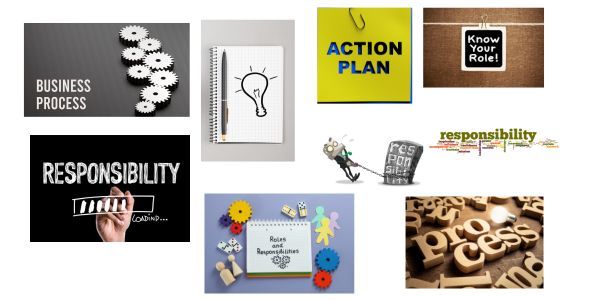The Business of Process Mapping
The Business of Process Mapping
In this discussion, we delve into the concept of business process mapping, its components, and its importance in organizational reengineering efforts. Let's begin by defining what a business process map should entail.
A business process map serves as a visual representation outlining the steps, tasks, and decisions involved in executing a specific business process. It functions as a detailed flowchart, illustrating the sequence of actions necessary for process completion within an organization. Typically, a business process map includes:
- Steps and Tasks: Each stage or task within the process is depicted as a box or symbol, clearly indicating the actions required at each phase.
- Flow of Operations: Arrows or lines connect these boxes, indicating the order and direction of the process flow, illustrating how tasks are interconnected.
- Decision Points: Diamonds or specific symbols denote decision-making junctures where choices dictate subsequent steps in the process.
- Start and End Points: Clear markers indicate where the process initiates and concludes.
- Inputs and Outputs: Information regarding inputs required at each step and the anticipated outputs.
Business process maps serve various purposes, including enhancing process comprehension, identifying inefficiencies, facilitating employee training, and standardizing workflows. They can be tailored to varying levels of detail based on process complexity and organizational needs.
Now, addressing the question of why mapping both current and target processes is essential:
Mapping existing processes reveals two critical aspects to stakeholders.
Simply put:
- The case for change.
- What stinks about what we do today?
- How bad does it stink?
- What can we do to fix it?
2. Shows if the scope of the change is feasible.
- What doesn’t stink about what we currently do?
- Why does it not stink?
- Can we save and reuse those portions of the process requiring no change?
Visualizing existing inefficiencies provides a compelling rationale for change and aids in gauging the magnitude of required modifications. By presenting adjustments as incremental rather than wholesale transformations, organizations can enhance employee receptiveness to new processes, thereby increasing adoption rates.
Following process mapping, the next step involves creating a RACI chart to delineate individual roles and responsibilities within the target process. The RACI framework categorizes stakeholders into four key roles:
- Responsible (R): This role refers to the person or people who complete the task. They are the ones who do the work to achieve the task. There can be multiple people responsible for a single task.
- Accountable (A): This is the person who is ultimately accountable for the correct and thorough completion of the task. This person must sign off or approve the work that the Responsible person or group completes. There must be exactly one person accountable for each task to ensure clear ownership. Many leaders don’t know what they are accountable for, and this leads to an inability to properly lead their teams. This process helps to eliminate that.
- Consulted (C): These are the people who need to be consulted before a decision or action is taken. This typically involves two-way communication and is inclusive of individuals who provide input based on their expertise, which is necessary for the task.
- Informed (I): This group consists of those who need to be kept informed of progress and outcomes. They do not contribute directly to the task but need updates on its progress, typically through one-way communication.
The RACI chart is created as a matrix, with tasks or decision points listed along one side and the organization or team members roles along the other side. The cells of the matrix are filled with the letters R, A, C, and I to show who is Responsible, Accountable, Consulted, and Informed for each task. Utilizing a RACI chart clarifies roles, enhances stakeholder engagement, and streamlines decision-making and task execution.
With this understanding, you're equipped to embark on process mapping endeavors.
Feel free to reach out for further clarification or to discuss any inquiries or insights.
Shon Isenhour
CMRP CAMA CMP
Eruditio
(843) 810-4446
In this discussion, we delve into the concept of business process mapping, its components, and its importance in organizational reengineering efforts. Let's begin by defining what a business process map should entail.
A business process map serves as a visual representation outlining the steps, tasks, and decisions involved in executing a specific business process. It functions as a detailed flowchart, illustrating the sequence of actions necessary for process completion within an organization. Typically, a business process map includes:
- Steps and Tasks: Each stage or task within the process is depicted as a box or symbol, clearly indicating the actions required at each phase.
- Flow of Operations: Arrows or lines connect these boxes, indicating the order and direction of the process flow, illustrating how tasks are interconnected.
- Decision Points: Diamonds or specific symbols denote decision-making junctures where choices dictate subsequent steps in the process.
- Start and End Points: Clear markers indicate where the process initiates and concludes.
- Inputs and Outputs: Information regarding inputs required at each step and the anticipated outputs.
Business process maps serve various purposes, including enhancing process comprehension, identifying inefficiencies, facilitating employee training, and standardizing workflows. They can be tailored to varying levels of detail based on process complexity and organizational needs.
Now, addressing the question of why mapping both current and target processes is essential:
Mapping existing processes reveals two critical aspects to stakeholders.
Simply put:
- The case for change.
- What stinks about what we do today?
- How bad does it stink?
- What can we do to fix it?
2. Shows if the scope of the change is feasible.
- What doesn’t stink about what we currently do?
- Why does it not stink?
- Can we save and reuse those portions of the process requiring no change?
Visualizing existing inefficiencies provides a compelling rationale for change and aids in gauging the magnitude of required modifications. By presenting adjustments as incremental rather than wholesale transformations, organizations can enhance employee receptiveness to new processes, thereby increasing adoption rates.
Following process mapping, the next step involves creating a RACI chart to delineate individual roles and responsibilities within the target process. The RACI framework categorizes stakeholders into four key roles:
- Responsible (R):
This role refers to the person or people who complete the task. They are the ones who do the work to achieve the task. There can be multiple people responsible for a single task.
- Accountable (A): This is the person who is ultimately accountable for the correct and thorough completion of the task. This person must sign off or approve the work that the Responsible person or group completes. There must be exactly one person accountable for each task to ensure clear ownership. Many leaders don’t know what they are accountable for, and this leads to an inability to properly lead their teams. This process helps to eliminate that.
- Consulted (C): These are the people who need to be consulted before a decision or action is taken. This typically involves two-way communication and is inclusive of individuals who provide input based on their expertise, which is necessary for the task.
- Informed (I): This group consists of those who need to be kept informed of progress and outcomes. They do not contribute directly to the task but need updates on its progress, typically through one-way communication.
The RACI chart is created as a matrix, with tasks or decision points listed along one side and the organization or team members roles along the other side. The cells of the matrix are filled with the letters R, A, C, and I to show who is Responsible, Accountable, Consulted, and Informed for each task. Utilizing a RACI chart clarifies roles, enhances stakeholder engagement, and streamlines decision-making and task execution.
With this understanding, you're equipped to embark on process mapping endeavors.
Feel free to reach out for further clarification or to discuss any inquiries or insights.
Shon Isenhour
CMRP CAMA CMP
Eruditio

All Rights Reserved | Eruditio®
All Rights Reserved | Eruditio®
Email: training@eruditio.com
Eruditio®
421 Wando Park Blvd Ste120,
Mt Pleasant, SC 29464
T (843) 375.8222 Eruditio®
Email: training@eruditio.com 421 Wando Park Blvd Ste120,
Mt Pleasant, SC 29464
Email: training@eruditio.com
Eruditio®
421 Wando Park Blvd ste120,
Mount Pleasant, SC 29464





